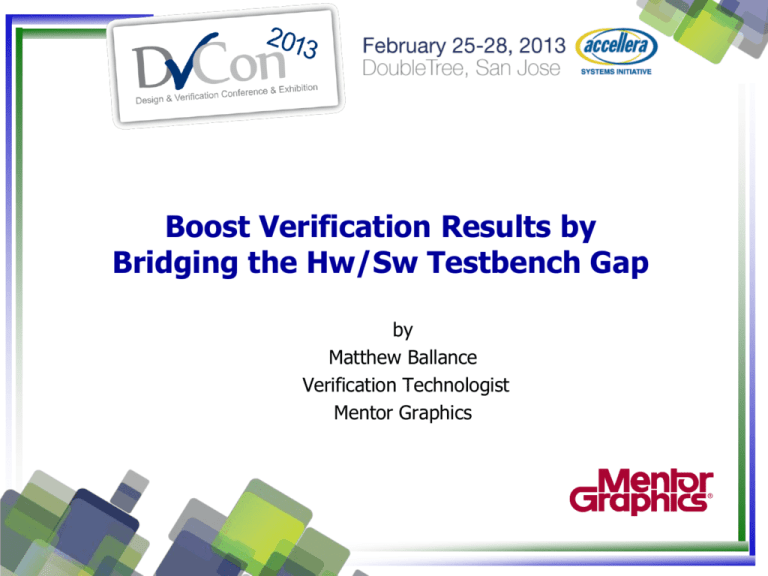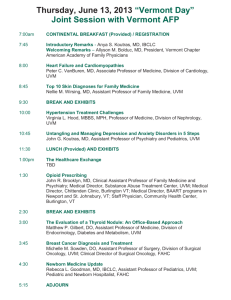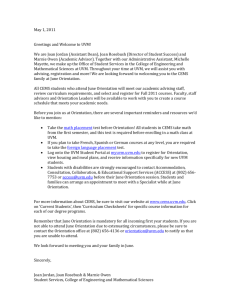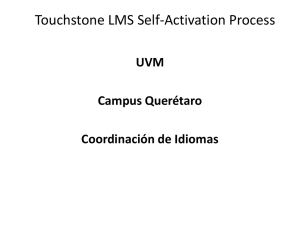What is the UVM SDV Package?
advertisement

Boost Verification Results by
Bridging the Hw/Sw Testbench Gap
by
Matthew Ballance
Verification Technologist
Mentor Graphics
Agenda
• Block-level verification techniques
• SoC-level verification and the testbench gap
• UVM Software-Driven Verification package
2 of (total number of slides)
Sponsored By:
Block-level Verification
Sponsored By:
• Verification from the outside in
– Plan, create scenarios to verify
– Apply at the design interfaces
– Confirm correctness of results
• Over a decade of tool development and standardization
– Automation
• Constrained random generation
• Intelligent testbench automation
– Standardization – Verilog, VHDL, SystemVerilog
– Methodology and reuse
• AVM,OVM,VMM,UVM
3 of (total number of slides)
SoC Verification
• Software central to design operation
• Verification from the outside in
– VIP connected to design interfaces
• Verification from the inside out
– Software running on the processor
• Challenges
– Difficult to coordinate Hw, Sw scenarios
– Little or no automation for Sw test creation
– Difficult to extract data from Sw test
4 of (total number of slides)
Sponsored By:
Gap? What Gap?
Sponsored By:
Hardware Domain Info
Software Domain Info
•
•
•
•
• Info/error messages
• Software state
• Sw scenario control
Test configuration
Automated test stimulus
Analysis-data collection
Hw scenario control
5 of (total number of slides)
The Need Isn’t New
Sponsored By:
• Hw/Sw Testbench connections aren’t new
• Often addressed environment-specific requirements
– Signal software test pass/fail
– Obtain randomized data
• Often proprietary
– Project / company specific
– Difficult to reuse
• Not UVM-centric
– Connecting existing UVM infrastructure requires work
6 of (total number of slides)
What is the UVM SDV Package?
Sponsored By:
• UVM-based package to enable Software-Driven Verification
– Connects Hw and Sw domains
– Simplifies coordination of Hw/Sw verification scenarios
• Scalable across environments
– Block-level verification in simulation
– SoC-level in simulation
– SoC-level in emulation
• Light-weight Sw components
– Small memory footprint
– Low processing overhead
7 of (total number of slides)
UVM SDV Architecture
• ‘C’ API
• SystemVerilog UVM-based classes
• Modular communication mechanism between Hw/Sw
– Shared memory
– DPI
• App-level services
– Hw/Sw synchronization
– Sw stimulus from UVM
– Sw state to UVM
– Sw-initiated Hw stim
8 of (total number of slides)
Sponsored By:
Base Hw/Sw Synchronization
• Sw API to pack/unpack data structures
• Obtain Configuration information from UVM
– Test-customization parameters
• Send Sw messages to UVM
– Enables common management of Hw/Sw status
– Reduced overhead vs printf via UART
• Sw control of objections
– Enables Sw to participate in test termination
9 of (total number of slides)
Sponsored By:
SW Stimulus from UVM
• Enables SW to drive stimulus generated in UVM
• Sequence item packed/unpacked by UVM API
• Item unpacked by SDV ‘C’ API
• Reuse existing UVM
– Sequences
– Sequence items
– Sequencers
10 of (total number of slides)
Sponsored By:
SW Stimulus from UVM
Sponsored By:
SW-side Implementation
• Software implements the UVM driver component
• ‘C’ API mirrors UVM sequencer-port API
req_txn req, rsp;
uvm_sdv_sequencer_driver_t txn_drv;
• Initialize Sw driver
• Get sequence item
• Signal item done
11 of (total number of slides)
uvm_sdv_sequencer_driver_init(&txn_drv,
“*.m_sdv_driver”, // inst path of drv
&req_txn_unpack, // unpack function
&rsp_txn_pack);
// pack function
while (true) {
uvm_sdv_sequencer_driver_get_next_item(
&txn_drv,
&req);
uvm_sdv_sequencer_driver_item_done(
&txn_drv,
&rsp);
}
SW State to UVM
• SW API exposes SW state via UVM analysis port
• Enables analysis of SW state in UVM
– Scoreboard
– Coverage
• More efficient than printf
– Reduce analysis overhead
• Example:
– printf via UART: 1600uS
– Analysis port: 50uS
12 of (total number of slides)
Sponsored By:
SW State to UVM
Sponsored By:
SW-side Implementation
• SW initializes an analysis port
– Specifies path of publisher in UVM environment
• Initialize analysis port
• Perform operation
uvm_sdv_analysis_port ap;
sw_txn state;
uvm_sdv_analysis_port_init(
&ap, “*.m_state_pub”,
&sw_txn_pack);
while (true) {
process_data();
state.A = read_A();
state.B = read_B();
• Read Sw state
• Publish to UVM env
13 of (total number of slides)
uvm_sdv_analysis_port_write(
&ap, &state);
}
Initiate UVM Stimulus from SW
• SW can launch sequences in UVM environment
– Launch any sequence on any agent
• SW can monitor completion
14 of (total number of slides)
Sponsored By:
Initiate UVM Stimulus from SW
Sponsored By:
SW-side Implementation
• Sequence-launch call specifies
– Sequence name
uint32_t id;
– Sequencer path
id = uvm_sdv_sequence_start(
“traffic_gen_seq”,
• Start is non-blocking
“*.traffic_seqr”);
• API returns run status
15 of (total number of slides)
// Perform other operations while
// the sequence is running
while
(uvm_sdv_sequence_is_running(id))
{
// Run software activity
process_data();
}
Extensibility
Graph-Based Stimulus
• Extension API provided for new applications
• Coordinated Hw/Sw tests benefit from stimulus that is
– Sequential
– Dynamically reactive to Hw/Sw state
• Graph-Based Stimulus
– Procedural interaction with Sw
– Stimulus/feedback mixed
• Enables description of complex scenarios
16 of (total number of slides)
Sponsored By:
UVM Software-Driven Verification
• Reusable infrastructure
– Easily customized for specific environment
• Connects Hw and Sw domains
– Extends UVM services to Sw domain
– Extensible to domain-specific applications
• Enables automation and visibility
– Automated stimulus generation
• Random, Intelligent
– Sw-state visibility
• Enables coordinated Hw/Sw tests
17 of (total number of slides)
Sponsored By:
Q&A









